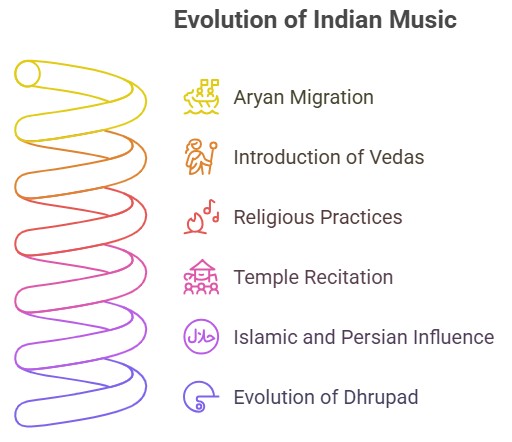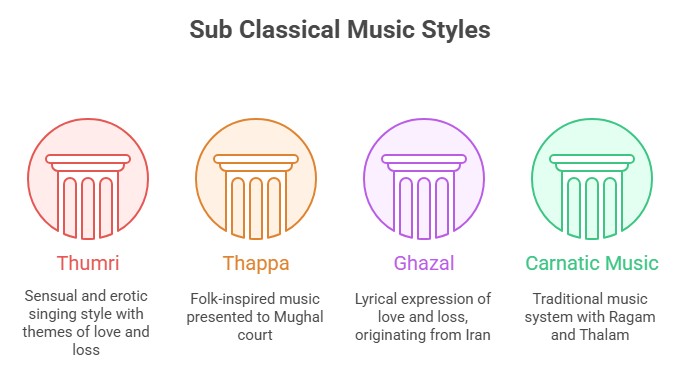Music is the soul of any culture, and India boasts a rich history of innovative music. According to legend, Narada Muni introduced music to the world. Evidence of a seven-holed flute from the Indus Valley Civilization signifies its ancient presence. The Sama Veda and Gandharva Veda, further emphasize music's spiritual significance and scientific aspects.
- The Gandharva Veda, or the science of music, is an Upaveda of the Sama Veda.
History of Indian Music
- It is generally accepted that the religious practices of the Aryan people, who came in India around 3,000 years ago, are where the roots of Indian classical music may be found.
- The Vedas, which literally translates as "knowledge," are the foundational writings of ancient Hindu scriptures that the Aryans brought with them. Their worship ceremonies essentially revolved upon the well planned and ordered recital of these lines.
- Hindu temple recitation shaped music's genesis.
- The appearance of North Indian music was altered by the introduction of Islamic and Persian components. For instance, by the 15th century, the Dhruvapad or devotional style had evolved into the Dhrupad style.
Classical Music is of Two Types
- Hindustani Music:
- The Hindustani school of music places more emphasis on the structure of the music as well as its improvisational potential.
- Hindustani music has ten primary vocal genres, including the "Dhrupad," "Dhamar," "Hori," "Khayal," "Chaturang," "Ragasagar," "Tarana," "Sargam," and "Thumri."
Dhrupad
- One of Hindustani classical music's oldest and most opulent genres.
- It has reference in Natyashastra (c. 200 BC–c. 200 AD).
- Reached its pinnacle in the court of Akbar, the Mughal emperor.
- Tansen, along with other renowned musicians like Swami Haridas and Baba Gopal Das, were employed and supported by Akbar. Tansen is regarded as one of the Navaratna or nine diamonds of the Mughal court.
Khayal
- This fashion industry's inception was credited to Amir Khusrau.
- It is used by artists because it allows for more room for improvisation.
- Based on a collection of brief songs with two to eight lines, it is also known as a "Bandish."
- Khayal also features a brief narrative and is composed in a certain raga and tala.
- Major Gharanas: Bhendibazaar Gharana, Gwalior, Kirana, Patiala, Agra
Tarana Style
- The rhythm of this technique is highly important.
- The melody serves as the structure.
- It has a lengthy vocabulary and is sung quickly.
- The singers must have particular training and expertise in manipulating rhythms because it concentrates on producing rhythmic concerns.
- Amir Khusro (13th–14th century) created it, and Guru Gobind Singh (10th Sikh Guru) incorporated it into his works.
Sub Classical Styles of Classical Music
Thumri
- "The lyric of Indian classical music" is another name for this sensual and erotic singing style.
- The majority of the poems deal with love, loss, and dedication.
- Unique feature: Erotic content that is picturesquely portrayed from the many events in Lord Krishna and Radha's life.
Thappa
- It gained legitimacy as it was presented to the Mughal court of Emperor Muhammad Shah.
- Originated from the folk songs of the North-West Indian camel riders.
Ghazal
- Used as a lyrical phrase to portray the pain of separation and loss as well as the beauty of love despite suffering.
- Reached its pinnacle under the Mughal era.
- Had its beginnings in Iran in the 10th century.
- Prominent poets who wrote ghazals during the 13th century include Rumi, who was a Persian poet and mystic, and Amir Khusro, who is often credited as the first expounder of the ghazal.
- Other famous personalities: Muhammad Iqbal and Mirza Ghalib.
- Carnatic Music
- The Sanskrit word Karnâtaka Sangîtam, which refers to "traditional" or "codified" music, is whence Carnatic music gets its name.
- It has a long history and tradition and is made up of a system of Ragam (Raga) and Thalam (Tala).
- Tamil Nadu, Kerala, Andhra Pradesh, and Karnataka are south Indian states where Carnatic Sangeet has flourished. These states are renowned for giving Dravidian culture a powerful portrayal.
Folk Music
Every State has a distinct musical style that is built on the cultural affirmation of its residents. The folk tradition has no set rules; it is the music of the people.
|
State
|
Music
|
|
Bengal
|
Baul
|
|
Jammu & Kashmir
|
Wanawan
|
|
Madhya Pradesh
|
Alha & pai
|
|
Rajasthan
|
Panihari
|
|
Maharashtra & Goa
|
Ovi
|
|
Rajasthan
|
Maand
|
Recent Developments in Indian Music
Classical art forms hold significant cultural capital, attracting the socio-cultural elite and signifying social status.
- SPIC MACAY, founded in 1977, promotes classical arts alongside other forms, emphasizing yoga and meditation.
- Youth Association for Classical Music: It is an initiative in Chennai that focused on providing a performance platform for artists below the age of 30 and taking Carnatic music to school children.
- Various organizations now aim to engage the youth using updated technology.
- However, classical music faces challenges rooted in its intimidating culture:
- Everyone invested in these musical forms refuses to look within and reflect on how the culture we exude is intimidating and fear inducing.
- Caste and class overflow in every activity associated with classical music.
Importance of Dance and Indian Music
Cultural Importance
- Religious ideas: In traditional Indian culture the function of dance was to give symbolic expression to religious ideas.
- The figure of Lord Shiva as Nataraja represents the creation and destruction of the cosmic cycle. It clearly shows the popularity of dance form on the Indian people.
- Celebrate the festivals: They were an essential part of celebrating a festival.
- Different instruments: The Ancient people used many types of musical instruments like balag, cymbals, rattles, flutes, drums, etc.
- A bronze image of a dancer was found in the excavation at Mohen-jo-daro is evidence that dance too, was important in the Harappan Civilization.
- Communication: They were seen as an essential component of creation since they could communicate with the gods and convey all kinds of life and death.
Recent Developments by Government
- The development of the classical dances was aided by the founding of the Sangeet Natak Akademi in Delhi and its affiliated centres.
- Prestigious festivals like Khajuraho, Konark, Dhauli Kalinga, Kalidas, Mukteshwar, Soorya, Ellora, and Nishagandhi showcase the exquisite portrayal of Indian classical dances.
- With the establishment of Music and Dance Universities like Indira Kala Sangeet Vishwavidyalaya in Khairagarh, Raja Mansingh Tomar University in Gwalior, etc., as well as numerous Institutions like Akhil Bharatiya Gandharva Mahavidyalaya Mandal and Prayag Sangeet Samiti, the classical dances flourished and advanced.
- Odissi dancer-Guru Jaya Mehta pens her new book Nritya Katha Dance Stories for Children after her debut as an author with The Poetic Saree, a collection of dance poems.
- The 80-page picture book published by the National Book Trust of India narrates the stories of nine Indian dance forms. “A child discovers an Indian classical dance form through every story,”.
- Bharatnatyam, Kuchipudi, Manipuri, Kathakali, Kathak, Chhau, Mohiniyattam and Sattriya are the dance forms featured. Jaya has also added a bit of the Bihu dance form, in the Sattriya story.
- For the past 11 years, the National Centre for the Performing Arts (NCPA) has steadfastly been trying to familiarise people with culture from different regions of the country via the medium of local folk traditions.
- Ghoomar from Rajasthan, Dandiya and Garba are among the list of the world’s top 10 most amazing local dances from India.
- Lavani became well known outside Maharashtra — throughout India and even outside the country — following its use in popular media such as cinema.
Promotion of Indian Arts, Culture and Heritage:
- Centre for Cultural Resources and Training (CCRT) organizes various training programmes on regular basis towards sensitizing in-service teachers for promotion and preservation of Indian Arts, Culture and Heritage.
- In each Training Programme regular sessions are held on various Classical Dances, Carnatic Classical Music and Hindustani Classical Music.
- The CCRT also organizes programmes for govt. & non-govt. (NGOs) school students under its Extension and Community Feedback programme in which sessions on Performing Arts are organized.
- In addition to this, CCRT paid a token honorarium and conveyance to the Experts and his/her accompanists to promote and encourage the Art and Artists.
- CCRT is also implementing following scholarship/fellowship schemes in various performing, visual & literary art fields:
- Cultural Talent Search Scholarship Scheme
- Award of Scholarships to Young Artists (SYA)
- The Fellowship Scheme for the Award of Fellowship to outstanding persons in the Field of Culture
Conclusion
Classical dance is a performing art that serves both entertainment and instructional purposes. Its origins can be traced back to early dance styles performed during religious festivals and rituals. Classical dance, being deeply rooted in classical ballet and opera, holds a significant place in the world of art. These dance styles have a rich and illustrious history in ancient Greece and Rome.
Classical music is undeniably complex, but it is not the only one. Classical music cannot become ‘mass’ but it needs to reflect the diversity in Indian society. Today, when corporations insist on diversity in recruitment, it is time social diversity becomes an active action plan in classical music.












